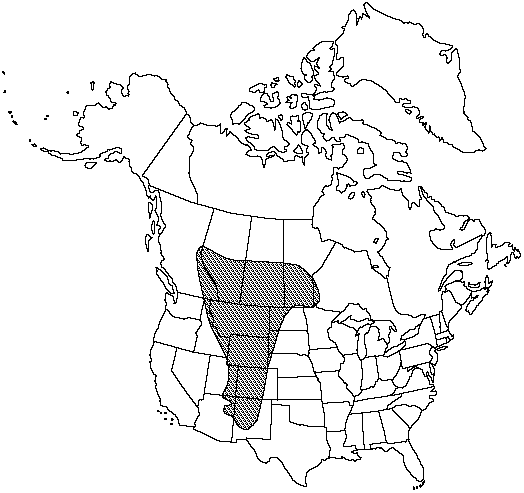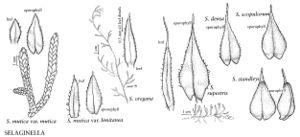Selaginella densa
Mem. New York Bot. Gard. 1: 7. 1900.
Plants terrestrial or on rock, forming cushionlike or loose mats. Stems decumbent or creeping, not readily fragmenting, irregularly forked, without budlike arrested branches, tips straight; main-stem upperside and underside structurally slightly different, conspicuously indeterminate, lateral branches radially symmetric, conspicuously or inconspicuously determinate, strongly ascending, 2–3-forked. Rhizophores borne on upperside of stems, throughout stem length, 0.2–0.35 mm diam. Leaves essentially monomorphic, in poorly defined pseudowhorls of 5 or 6, tightly appressed, ascending, green, linear to linear-lanceolate, (2.7–) 3–5 × 0.4–0.7 mm (upperside leaves smaller than underside ones, also smaller on ascending buds); abaxial ridges present; base long-decurrent, oblique, and glabrous on underside leaves, slightly decurrent, oblique, and sometimes pubescent on upperside leaves; margins long-ciliate, cilia transparent, mostly ascending or spreading on proximal 1/2, ascending on distal 1/2, 0.07–0.17 (–0.2) mm; apex slightly keeled to plane, rather obtuse, abruptly long-bristled; bristle white or transparent, puberulent, (1–) 1.25–1.9 mm. Strobili solitary, (0.5–) 1–3 (–4) cm; sporophylls ovatelanceolate, seldom ovate, abaxial ridges well defined, base glabrous, margins ciliate entire length or dentate near tip, apex usually long-bristled.
Habitat: Prairies, alpine meadows, dry rocky slopes, rock crevices, sandstone, quartzite or granite rock, and dry gravelly, clayey or sandy soil
Elevation: 1100–4000 m
Distribution

Alta., B.C., Man., Ont., Sask., Ariz., Colo., Idaho, Mont., Nebr., N.Mex., N.Dak., S.Dak., Utah, Wyo.
Discussion
Selaginella densa has been treated as including three varieties: var. densa, var. scopulorum (Maxon) R. M. Tryon, and var. standleyi (Maxon) R. M. Tryon (R. M. Tryon 1955), which are recognized here at the species level. Intermediates between S. densa and the other two species of the group may represent ecological variations of the species, hybrids between species within the complex, or hybrids with other closely related species, such as S. watsonii. This group is in need of detailed systematic studies. Megasporangia with only two well-developed megaspores have been observed, which may indicate apogamy and the presence of different races as found in S. rupestris.
Selected References
None.
Lower Taxa
"entire" is not a number.
